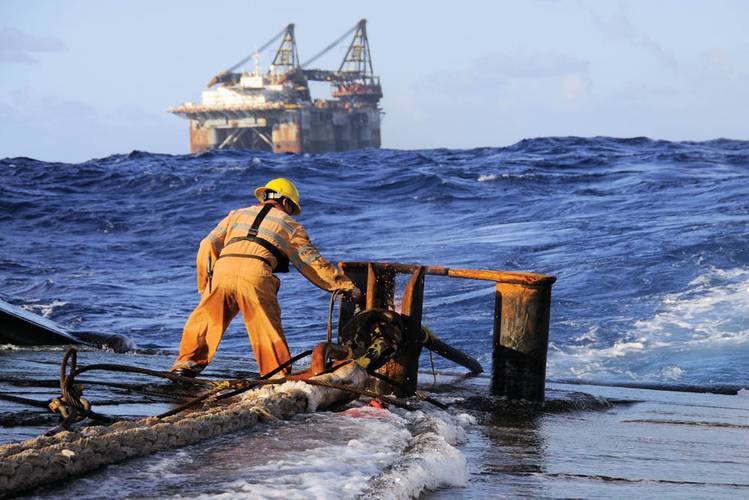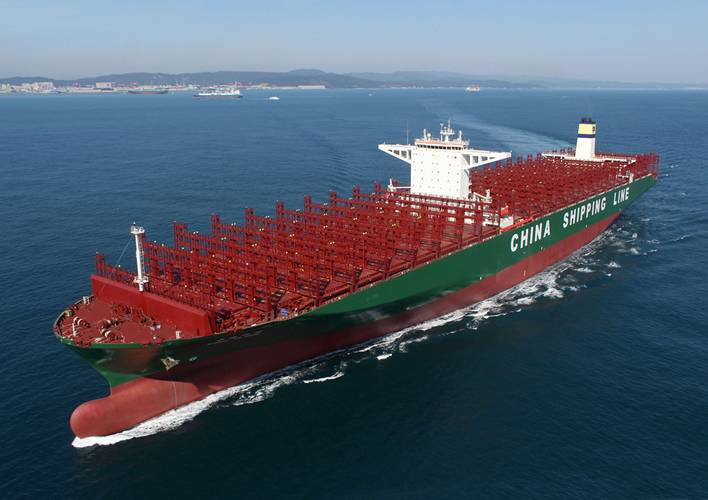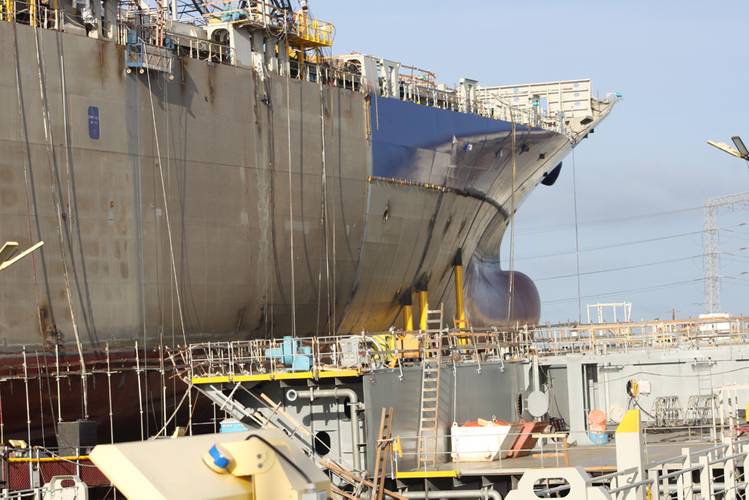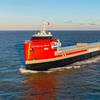Global Maritime Trends: U.S. Shipbuilding Will be Vibrant for a Generation
In trying to make sense of the global, mobile maritime industry, there is no better ‘go to’ than Shashi N. Kumar, Ph.D., Master Mariner, Fulbright Senior Specialist Fellow, Emeritus Professor of International Business & Logistics, Academic Dean, United States Merchant Marine Academy (USMMA). Last month we met with Dr. Kumar in his office to put emerging global maritime trends in perspective.
“The views expressed in this article are Dr. Kumar’s own and not those of the U.S. Merchant Marine Academy, the Maritime Administration, the Department of Transportation or the United States government.”
The World: When you look at the global shipping market, what do you see and why?
I’m one of those who thought that we would see clearer ‘silver linings’ in 2014 but obviously that did not quite happen for a number of reasons. The world economy did not shake out as well as I estimated. I believe the updated IMF estimate for 2014 world economic growth is 3.3% which is not too bad but certainly not good enough to energize the maritime industry out of its 2012/2013 slump. To me, status of the world economy is a very important driver of the ups and downs in global shipping. Isolated shipping markets are certainly doing a lot better than what was anticipated, case in point the market for VLCCs. But then you also have the other extreme, the dry bulk sector, where it couldn’t get any more worse.
The Dry Bulk Market: What will get that sector moving again?
A very interesting question. As you know, this is a market with very low barriers to entry and one which we maritime economists often postulate as being close to the classic perfect competition model. Anybody can enter the dry bulk market if you have one ship. It’s not difficult for an entrepreneur to find the right type of financing to get that one ship to make market entry. And if you are an established owner or operator in this market, expanding your fleet with the “right” type of financing became easier in the last few years. And of course, there are many shipyards especially in China offering excellent incentives for building new tonnage. Then, there are the hedge funds and equity investors who have contributed in their own ways to the black swans haunting dry bulk shipping today. What a perfect recipe for market destruction (from the owners’ perspective)!
Correspondingly, in the last couple of years, trade volumes have not kept pace with the increase in supply of shipping capacity. The Chinese have cut back on their commodity imports, notably coal, and even iron ore to some extent. We also have a serious issue with ship sizes, in particular the gigantic Valemax 400,000DWT dry bulk carriers, each of which replaced several smaller ships in the Brazil-China trade. Unfortunately, the displaced smaller ships do not go away; they remain part of the tonnage until their lifespan is complete.
There is obviously too much surplus tonnage in the dry bulk market. We are witnessing some of the more innovative owners switching over their bulk carrier newbuilding orders to tankers, but this alone will not solve the (dry bulk overcapacity) problem. It is really refreshing to see the recent decline in dry bulk newbuilding orders. I am hoping that this market will turn around by 2017.
In your opinion, what was the genesis of private equity money in the shipping industry.
There was a big influx of private equity investment in shipping. My simple theory is that they were looking for quick returns. Now, upon seeing the outcomes, they are attempting to limit their exposure through consolidation or even market exit strategies. I think they have learned that shipping is not the easy bonanza they expected.
What are the key economic and statistical indicators that you monitor to gauge the health of the shipping industry.
We touched on the GDP factor, which is number one. There is a rough rule of thumb that if you know the GDP growth, the consumer goods being traded is roughly twice that level. That was the historic yardstick, but now it’s more like 1.5 times the GDP.
Why is that?
Global economic growth is like a rising tide that lifts all nations and their trading requirements. So, over the years, world trade patterns have changed and also what are being traded. These dynamics have impacted the variables that dictate world trade, and we have to make adjustments to our historic assumptions based on evidence and market outcomes. This is one such adjustment.
OK. Getting back to the economic and statistical indicators, which are most important?
Certainly GDP, particularly what is going on in the OECD and non-OECD countries, and most certainly what is going on in China and the other BRIC nations. This is from a broad macro level.
From a micro level, supply and demand data are fundamental to analyzing any industry, shipping included. I review these regularly at the sub-market levels to get a good grasp of what to expect and make my own projections.
One other important factor I keep track is ship’s speed. The impact of changes in ship’s speed on tonnage supply is phenomenal and often doesn’t get the recognition it deserves. Look at oil tankers. There’s a recently released report that says if VLCCs increase their speed from 11 knots to 14 knots you are putting 18% of the current VLCC fleet out of business (assuming the cargo volume does not change.) Containerships are operating at 16 to 18 knots right now. What happens if they decide to go back to 21 or even 24 knot speeds based on the lower oil price? I think the current woes of liner companies would only multiply if they were to speed up their ships.
Do you see them starting to speed up again?
That is my concern whenever there is a drop in bunker prices – particularly in the liner market where one may be tempted to seek a market niche or service differentiation. What is to stop them from marketing “faster services” as a competitive strategy? It all comes down to market discipline, and this industry has shown that discipline is not our strong point1 It is rather ironic by the way because when I speak with budding mariners (my students) my mantra is always the importance of “self-discipline” for a successful career at sea.
As you mentioned, supply and demand is a basic for any industry, yet for the shipping market as a whole there always seems to be perpetually out of balance. Is there anything you see that could bring it back to balance.
I see Adam Smith’s “Invisible Hand” here perhaps more than most other industries. It is human nature to be greedy; the more we have, the more we want. I am sure every shipowner believes that s/he is the smartest one and everyone else is dumb. They invest in new tonnage, in most cases, a better ship but by the time she is delivered, the others have joined the bandwagon too. The thought that they will alone succeed and everyone else will go broke is far from reality and totally irrational. The role of some equity investors who have pumped in a lot of new funds in a market that they don’t quite understand hasn’t helped the situation either. The shipping milieu and market sense which were very much a hallmark of traditional ship owners is no longer the case in the industry but for some rare exceptions. The shipping industry is not about making a quick buck, and it seems many are destined to learn this the hard way!
So it sounds like, with all of the various business and political factors that affect shipping, long-term success really still lies in knowing the business.
I strongly believe that this is the most essential ingredient to succeed in this business. Are we really all that different? No! Just like other success stories, to succeed in shipping, one must know what works here, why it works, how it works, and when changes must be made. It is very easy to go around advocating changes without knowing the fundamentals; to me, that is a recipe for disaster. Undoubtedly, a company must be profitable to remain viable but its passion must not be limited to making a quick buck. They need to understand the business they are in and its core values, and have some of the traits that good traditional shipowners have demonstrated over the years--their passion for ships and the industry, their trust and respect for their employees and yes, their love for the oceans and everything maritime … I think these are largely missing today.
GDP, Supply & Demand, Ship’s Speed … are there any other factors that you consider crucial to studying this market?
There are numerous statistical indicators that one can monitor. Many trade journals and research organizations provide copious data today if one is interested in keeping up with the markets. So, to study shipping markets, one should religiously follow what is happening in individual trades and markets. Then, there are the random political events that seem to be happening with unusual regularity these days; being generally aware of the global political economy is vital in our business. Eventually, it all comes down to simple economics—nothing is as crucial as basic supply and demand information. By the way, one has to dig deep into the sub-markets. For example, studying the tanker market entails analyzing the VLCC market, the Suezmax market, the Aframax market as well as the markets for product tankers. And of course, today, it would also include the market for LNG tankers, VLGCs, chemical tankers, and so on. The same applies to the other two fundamental shipping markets. Once you are armed with all the supply statistics, plug in your data on current and projected trade volumes. There are qualitative variables that one should be aware of such as new environmental regulations and their likely impact on markets, and also the state of industry expectations measured through “shipping confidence” estimates. In my opinion, shipping markets are fairly easy to analyze and today we have sufficient readily available data. Before I forget, you need one more vital ingredient—the passion to follow these markets religiously on a day-to-day basis, which again leads to my earlier comment on self-discipline.
The Tanker Market: An Overview
The big ships, the VLCCs, are doing very well and are in a very good position. Remarkably, even the Suezmaxes are finding good opportunities, and so are the product tankers with several new refineries opening up around the world, in the Gulf region as well as in South Asia. This is a good time to be in the tanker market, but obviously there are some ominous signs looming on the horizon.
What has been the driver for the tanker market?
The number one reason has been the supply of ships. Tanker owners have shown good market discipline, and they have stuck to their newbuilding strategy. The trade volume has picked up a little bit, and also the distances involved have lengthened which again increases the demand for tonnage. The ongoing contango situation with the low price of oil has created opportunities for some older VLCCs to be used as storage tankers, keeping them off the trading market. The storage tanker option is a smart money-making operation for those owners although no one knows how long this will last. We have already talked about slowing down ship’s speed. All these have helped the tanker market make a good rebound. But 2016 may be a different story with dry bulk operators and some equity investors seeking greener pastures here--newbuilding orders are gradually climbing. So, I am skeptical how 2016 will shape up by the end of the year.
Switching gears from the tanker market, what do you see when you look at the liner market?
Sir Yue-Kong Pao, the storied Chinese shipping tycoon and patriarch of the World Wide Shipping group which at one point owned 500 ships, was once asked, ‘Why are you not investing in liner shipping?’ His response: ‘Joining the liner market is like playing Russian Roulette; you know for sure you are going to die.”
I guess he had a point. I know Maersk Line is doing quite well now; they have cut down their unit cost by building bigger ships and enhanced their system-wide operating efficiency. But my question is: “How long will a shipping service strategy based solely on cost reduction sustain?” There is a limit to cost reduction strategies beyond which they will impact the quality of services provided.
So how about the Liner Market today?
High barriers to entry and concentration of market power. This market is very dear to me as it was the topic of my doctoral dissertation in 1993. I made a pretty elegant case then that the liner markets were contestable and new entry was feasible; I will have a tough time making that argument today. It’s not the game you want to play unless you belong to one of those giant liner alliances. It’s a tough market out there and the scale of investment required is truly major league!
When we spoke previously, you floated the notion that there should be a cap on the limit of the size of ships. Obviously, bigger ships present a host of new challenges, particularly on the salvage and recovery side of the business, which must invest in new technologies to be able to effectively help one of these behemoths in peril. When you look at the rapidly escalating size of ships, what do you think?
You raise a very good point. I remain very concerned about ships getting bigger and bigger. The insurance industry estimates that if one of these 20,000 TEU ships gets into a serious accident, the likely salvage operation would last a year, and incur a billion dollar liability. The other thing to consider: Where will these ships go? They can’t simply call at any niche port of their choice; all these big ships are going to congregate in the same ports—share the same restricted waters, and transit the same channels. This means more close quarters situations. Even though the industry is more safety conscious today and we provide a far superior education than ever before, the number of ships are also going up in addition to their size. I have known the sea for too long—it is not a very forgiving place when something goes wrong.
The Environment. Can you put in perspective initiatives in the maritime sector as compared to any other time period of your career.
I am so proud to be part of this industry in terms of all the great things we have accomplished environmentally. My affiliation with shipping began in the late 1970s as a deck cadet, and the difference today from those years is like night and day. The MARPOL regulations were just coming into effect during those years. We have come a long way since then in every which way I can think—be that the way the ships are constructed today or the myriad environmental regulations we comply with. The use of low-sulfur fuel, the impressive gains made in lowering CO2 emissions, the introduction of ballast water treatment systems, the use of LNG as a propellant--looking back 40 years ago, I could not have possibly imagined these paradigm shifts in how we operate commercial ships today. My only disappointment…if only the world could come to a consensus on environmental standards…it will be a lot easier to march to one tune, and the industry could deliver even more!
And the likelihood of that ever happening is …
Highly unlikely!
Concluding on the international side, where do you see strength and balance in shipbuilding?
The shipbuilding sector is going through its own pains and agonies. 2014 was not a good year overall. Many owners have cut back on their newbuilding plans, especially the owners of dry bulk carriers. China is emerging as the world leader in this market thanks to strong government support although many of its yards are in various stages of difficulty. There will be continued consolidation of the Chinese yards and they will slowly make an entry into building the more sophisticated ships such as LNG carriers. They are certainly aggressive with their promotional policies for shipbuilding, and the entire scenario involving the Valemax bulk carriers is a classic case study of successfully leveraging national political and economic interests.
Shipbuilding has become a highly specialized sector now. LNG ships worth almost $15 billion were ordered in 2014, almost twice as much as what was spent on the next highest—$7.8 billion on Capesize bulk carriers. It is believed that many of these LNG ships will be employed in carrying U.S. exports to the Far East and South Asia. In addition to the South Koreans, the Chinese and the Japanese, other new players are also likely to enter the highly sophisticated LNG shipbuilding market—a case in point is the ongoing discussion between shipyards in India and Korea to build LNG ships, supposedly to carry U.S. LNG exports to India.
Let’s switch gears and look at the U.S. market, which has been as vibrant as I’ve ever seen in my 21 years in this position. When you look at the U.S. maritime industry today, what do you see?
There is a lot of optimism and enthusiasm, something that has been missing for the last three or four decades. This is most visible in shipbuilding with virtually all the U.S. yards staying busy, building vessels for the brown water and the green water, and also some blue water ships. The recent delivery of the TOTE container ship from NASSCO is certainly a phenomenal moment to cherish. Overall, quite refreshing and long overdue.
What are the key drivers in this market today?
It is driven by the energy sector; there’s no question about it. We have become a pivotal swing factor in the global petroleum market. The drilling for shale oil and natural gas has created a variety of opportunities. I am not talking about just the transportation of those products but also about the whole host of support industries that they have generated and the associated project cargo movements. Then there are the investments in the petrochemical industry that has attracted a significant amount of foreign direct investment because of our low energy costs. Many of these activities are based in the south; in fact, my message to those seeking maritime career opportunities in the U.S. today is to “head south.” I believe our role as a key swing player in the energy market will last well into the next 20 to 30 years, which makes me conclude that our maritime rejuvenation and optimism is here for the long haul.
But won’t the current low oil prices effectively hurt the U.S. maritime business?
I do not believe that is the case. See the world market for oil tankers; it is a shining star right now despite the low oil prices. So, the American market should only be doing even better than the international market; that’s what my numbers confirm. The Saudi Arabian squeeze play is not going to affect our maritime business although there will be some temporary disruptions. Case in point, a reduction in the number of rigs in use. But then, recent figures indicate that those numbers have bottomed out. Overall, the U.S. production of oil has not decreased despite the OPEC strategy.
When you look at U.S. shipbuilding. Are there any specific drivers you see that will impact the business in the near term?
I think the focus will remain on the smaller ship sizes we discussed, with occasional orders for the bigger ones. The smaller ship market is very attractive, and will remain so for the foreseeable future. That’s where the business is right now, from the Coastal Fleet to the Offshore Supply Vessels and Drill Rigs. As for construction of blue-water ships, it will be driven by the fleet replacement strategy of our key Jones Act operators.
The Final Word.
Shashi N. Kumar’s thoughts on these ‘hot button’ topics.
• LNG as Maritime Fuel
“Here to stay. LNG will get more and more widely used by ships, particularly on new construction. I’m not anticipating a big refit business. With new construction at this time, if you’re not looking at LNG as an option, you’re not reading the tea leaves.”
• The Future of Slow Steaming
“I’m praying like hell for the shipowners to maintain their speed. Don’t raise your speed. They need to show discipline.”
• Maritime Piracy
“Piracy will go down. The Malaysia market is once again becoming a hot bed, but that’s more of the garden snake variety, siphoning fuel and selling it off. That’s a nuisance factor, and it has to be controlled. At the same time I’m concerned about unplanned disruptions to shipping through terrorism.”
(As published in the June 2015 edition of Maritime Reporter & Engineering News - http://magazines.marinelink.com/Magazines/MaritimeReporter)



















